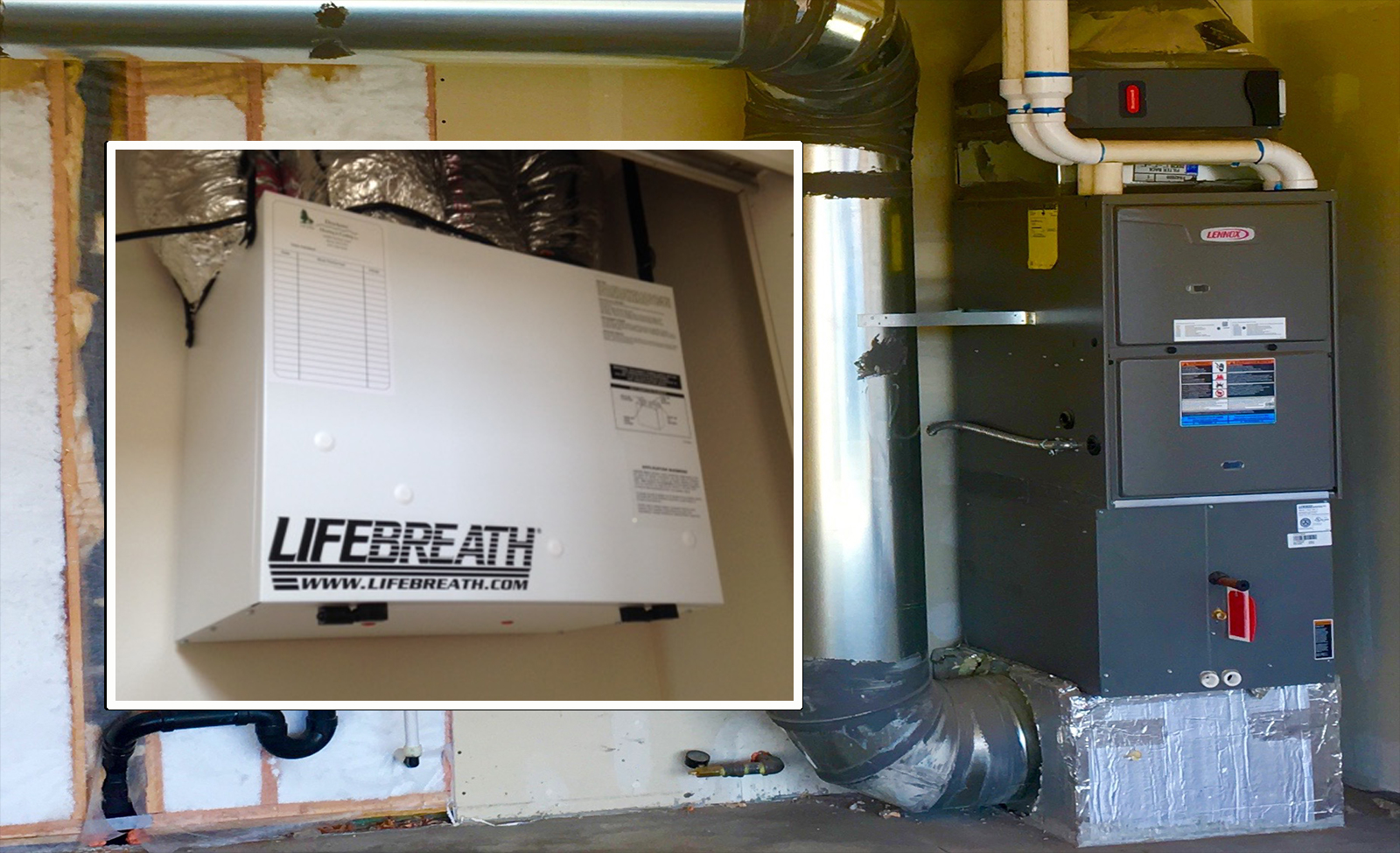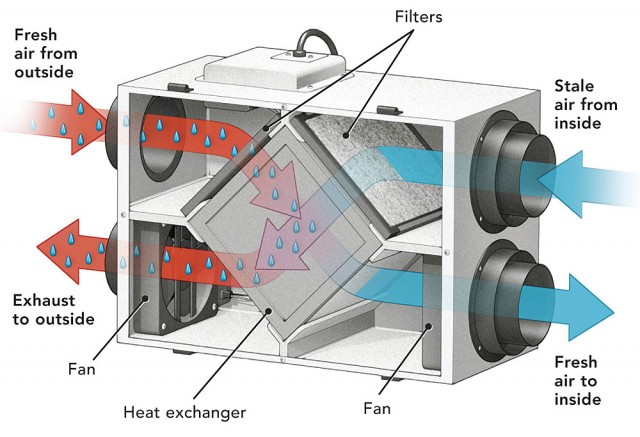Quick Guide: What to Consider Before Buying HRV
Wiki Article
Unveiling the Key Benefits and Uses of Heat Recovery Ventilation in Sustainable Layout
Heat Recovery Ventilation (HRV) systems play an important duty in sustainable design. They help with a continuous exchange of stagnant indoor air with fresh outside air, greatly boosting indoor air top quality. HRVs add to energy effectiveness by reclaiming warm from exhausted air, which can decrease energy costs. Comprehending the multifaceted benefits and applications of HRVs exposes their importance in modern style. What various other benefits do these systems supply in the pursuit of sustainability?Recognizing Heat Recovery Ventilation Systems
Heat recovery ventilation (HRV) systems are designed to enhance interior air top quality while reducing energy loss. These systems use a mechanical air flow method to exchange stale interior air with fresh exterior air, making certain a continuous supply of tidy air. By recording warmth from the exhaust air, HRVs precondition inbound air, decreasing the need on heating and cooling systems. This procedure not only enhances thermal convenience yet likewise adds to power efficiency in domestic and industrial buildings. Additionally, HRV systems help control humidity levels and minimize interior pollutants, advertising a much healthier living atmosphere. Their calculated application is crucial for achieving lasting style objectives, as they supply a balance in between energy preservation and passenger health.Exactly How HRV Systems Work
While numerous may know with air flow systems, understanding how warm healing air flow (HRV) systems operate is necessary for appreciating their advantages. HRV systems function by exchanging stale interior air with fresh outside air while transferring warm between the 2 streams. This procedure takes place in a warmth exchanger, where warm from the outward bound air warms up the inbound air throughout cooler months, decreasing power loss. Alternatively, in warmer months, the system can cool down inbound air using the cooler outgoing air. HRVs are geared up with fans to assist in air movement and filters to eliminate particulates, making sure a constant, balanced air flow procedure. This ingenious design not only boosts power effectiveness but also adds to preserving a comfortable interior atmosphere.Enhancing Indoor Air Top Quality
Interior air high quality can considerably affect health and wellness and health, making efficient ventilation crucial in modern-day homes. Heat Recovery Ventilation (HRV) systems play a crucial role in keeping indoor air quality by constantly exchanging stagnant interior air with fresh outside air. This process not just reduces airborne toxins yet likewise reduces humidity levels, which can lead to mold growth and breathing problems. HRV systems filter inbound air, getting rid of allergens and particulates, consequently providing a healthier living setting. In addition, these systems aid get rid of smells and unpredictable natural substances (VOCs) commonly located in household products. By guaranteeing a regular circulation of clean air, HRV systems add to a general better indoor ambience, promoting comfort and health for occupants.Energy Efficiency and Expense Cost Savings
Energy effectiveness attracts attention as a significant benefit of Heat Recovery Ventilation (HRV) systems. By catching and recycling the heat from worn down indoor air, HRVs reduce the power needed for home heating inbound fresh air, leading to lowered power usage. This performance equates into lower utility expenses, supplying significant expense savings for house owners and businesses alike. Furthermore, HRV systems commonly certify for power performance incentives and rebates, additionally boosting their monetary appeal. In time, the initial investment in HRV innovation can cause a positive return on investment with reduced energy expenses. Subsequently, the assimilation of HRV systems not just advertises lasting layout but likewise provides a functional option for accomplishing long-lasting energy financial savings and monetary benefits.Environmental Benefits of HRV

A multitude of environmental benefits arises from the application of Heat Recovery Ventilation (HRV) systems. By efficiently transferring warmth from exhaust air to incoming fresh air, HRVs considerably minimize the power required for home heating and cooling spaces. This power performance converts to reduce greenhouse gas emissions, adding to a reduction in the general carbon footprint of buildings. Furthermore, HRV systems improve interior air high quality by continually flowing fresh air, thus reducing the concentration of interior toxins and allergens. In addition, the reduction in power usage help in saving natural sources, making HRVs a necessary component of sustainable design. Overall, the ecological benefits of HRVs play a crucial duty in advertising a healthier earth and promoting environment-friendly building techniques.
Versatile Applications in Modern Design
Heat recovery ventilation (HRV) systems are progressively being integrated right into both property and business building projects. In property settings, HRVs improve interior air high quality while making best use of energy performance. In industrial areas, these systems enhance air flow approaches, showing their versatility in modern building applications.Residential Projects Assimilation
While modern architecture increasingly highlights sustainability, the combination of warmth healing air flow systems in household projects has actually arised as a useful service for enhancing interior air high quality and power efficiency. These systems effectively move warmth from exhaust air to incoming fresh air, decreasing power loss and reducing home heating or cooling needs. In new builds and retrofits alike, heat recovery ventilation can be effortlessly included, giving house owners with a much healthier living environment while reducing utility costs. Furthermore, with enhancing understanding of environmental influences, even more engineers and building contractors are acknowledging the long-term advantages of these systems. Therefore, warmth recovery air flow has come to be a vital element of lasting domestic layout, showcasing adaptability and dedication to environment-friendly methods.Industrial Spaces Optimization
As modern commercial rooms develop to satisfy the needs of sustainability and effectiveness, the application of warmth recovery air flow systems becomes a vital approach for maximizing indoor settings. These systems facilitate the exchange of stale indoor air with fresh outside air while reclaiming warmth power, considerably lowering power usage. This not just enhances convenience for residents but likewise assists in decreasing operational prices. Flexible applications can be observed in workplaces, retail spaces, and academic institutions, where air quality and temperature level control are extremely important. In addition, integrating warmth recovery air flow straightens with eco-friendly building accreditations, even more advertising ecological duty. Eventually, adopting such systems in business architecture not just contributes to sustainability objectives yet likewise fosters much healthier, extra productive rooms for customers.
Integrating HRV Into Sustainable Layout Practices
Incorporating warm healing air flow (HRV) systems into sustainable style methods offers significant advantages in power effectiveness and interior air top quality. By using HRV, developers can produce economical solutions that not only reduce power intake but likewise enhance the general comfort of indoor atmospheres. This placement with sustainability objectives positions HRV as a crucial element in contemporary architectural methods.
Power Performance Enhancement
By including warm recuperation ventilation (HRV) systems into lasting layout methods, architects and builders can considerably enhance energy effectiveness in modern-day buildings. HRV systems operate by capturing heat from outward bound stale air and moving it to inbound fresh air, lessening the power required for heating or cooling indoor areas. This process not just lowers reliance on typical cooling and heating systems yet additionally decreases total energy consumption. On top of that, HRV systems can assist preserve a constant interior temperature, decreasing peak power needs. By integrating these systems, buildings can accomplish substantial reductions in utility expenses and carbon footprints, lining up with sustainability goals. Eventually, HRV technology stands for a sensible remedy for boosting power performance in the developed setting, advertising even more accountable resource usage.Indoor Air High Quality Improvement
How can heat recuperation air flow (HRV) systems add to premium interior air high quality in modern structures? HRV systems efficiently exchange stale indoor air with fresh outdoor air while recovering warm power, decreasing temperature level fluctuations. This procedure reduces the focus of interior toxins, such as unstable organic compounds (VOCs), irritants, and moisture, which can degrade air top quality and effect passenger wellness. By preserving suitable humidity degrees and ensuring a continuous supply of tidy air, HRVs aid develop a much healthier interior atmosphere. Additionally, these systems can be integrated right into sustainable design techniques, advertising energy effectiveness together with enhanced air top quality. HRV Heat Recovery Ventilation. HRV technology plays a vital duty in progressing total passenger convenience and wellness in modern architectural designs.Economical Layout Solutions

Frequently Asked Inquiries
What Maintenance Is Needed for Heat Recovery Ventilation Equipments?

Upkeep for heat healing Get More Info air flow systems generally involves routine filter replacements, cleaning of warmth exchangers, examination of followers and air ducts, and guaranteeing correct drain. These jobs aid preserve performance and prolong the system's life expectancy gradually.
Can HRV Solutions Be Installed in Existing Buildings?
Heat recovery ventilation systems can without a doubt be set up in existing buildings. HRV Heat Recovery Ventilation. Retrofitting needs mindful preparation and assessment of the building's format, making certain compatibility with existing systems while maximizing energy efficiency and indoor air high qualityJust How Do HRV Equipment Effect Noise Degrees Inside?
HRV systems can influence indoor sound degrees by presenting sound from outside sources with air flow. Top notch installments usually integrate sound-dampening attributes, minimizing sound impact while offering efficient air exchange and preserving comfort inside.Exist Any Type Of Downsides to Making Use Of HRV Equipments?
The disadvantages of making use of HRV systems consist of prospective high preliminary costs, upkeep obstacles, and the opportunity of reduced interior air quality if filters are sporadically transformed, which might result in issues with moisture degrees.How Do I Choose the Right HRV System for My Needs?
Selecting the best heat recuperation ventilation system navigate to this website involves reviewing certain needs, such as constructing dimension, climate, and power performance goals. In addition, evaluating system features, installment demands, and maintenance factors to consider is vital for peak efficiency and contentment.Report this wiki page